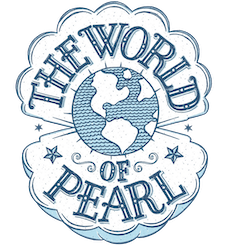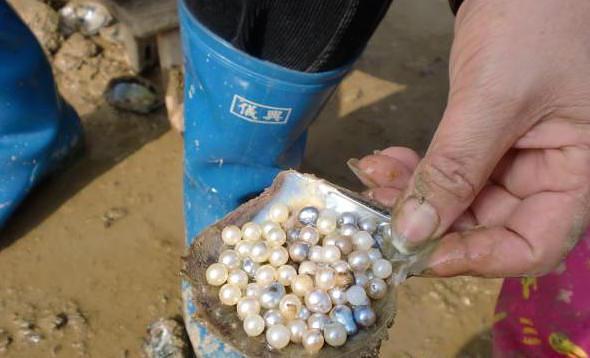The Color of Akoya Pearls – Cranberry?!
“Look … it’s a very rare cranberry pearl!” A young girl exclaimed into my screen, “You are so lucky!!” Granted, she wasn’t talking to me. She was talking to Susan who, a short time before me, had selected an oyster for her to open. I admit, I had actually tuned into one of the “open an oyster” parties that are so common on Facebook. And I watched a woman crack open a juvenile akoya oyster shell… the shell of a mollusk way too young to form its own pearl… and extract a little cranberry pearl. Hmmm… rare? “No,”I thought, “impossible.”
First there was no way this oyster was producing this pearl and secondly, it definitely wasn’t producing a cranberry colored pearl! But, as I read the comments and interactions online, I realized these Facebook live oyster opening parties were not about pearls. They were about connection. Women were online commenting on each others lives. They had formed a bit of a community and I have to admit, that warmed my heart. And then the next day my heart was broken again when a gentleman and his wife shuffled into my shop and asked how much their new pearls were worth. The wife had paid $50 for them at a, you guessed it, online oyster opening. And although I do not appraise pearls I told him we would sell those pearls for around $3. I felt awful to be the one to break this news to this unsuspecting couple.
The True Color of Akoya Pearls
What is the true color of akoya pearls? This is a good place to start when trying to understand pearls. When someone opens a juvenile oyster and pulls out a pearl of a certain color, arm yourself with the knowledge that that pearl did not go in that shell. Truth be told, almost all the pearls you see online did not originate in the oyster they are pulled out of.
When I was traveling through China back in 2013 I had arranged to tour a factory that takes these baby akoyas and puts the pearl inside and seals it back up. I was going to do a video expose for my YouTube channel and, at last minute, they cancelled. But, needless to say it is big business. Get a factory, put a pearl in an oyster, open the oyster and SURPRISE! It’s a cranberry! or a lemon! or chartreuse! The options are limitless,right? I admit, I totally get it! I fly all over the world to harvest pearls and I love the thrill of going to pearl farms and opening oysters for pearls. What fun! But many of you are confused because these akoya pearls have colored pearls in them… why? That is a great question! Here is a look at a true akoya pearl harvest:

In a true akoya pearl farm, you will find a pearl in the gonad of the mollusk. This is where the nucleus is placed so the pearl will form. Next, a mollusk that is making its own shell, can only make pearls the same color as its shell. Why? Because it uses the same pearl making material it uses to make its shell, to make a pearl. So, it is limited to the same colors of its mother of pearl to make a pearl!
The Fiji Gonad
Here is a great photo I took in Fiji where you can see the pearl in the thick white gonad muscle. You might notice, this is not an akoya oyster. Once you start looking, the mollusks are all different … and it’s all so cool!

When akoya mollusks are reseeded with a pearl, the pearl is typically in the fleshy material of the mollusk. That is one way you know it has been reseeded! If you open a oyster and, voila, there is a pearl…. the pearl has been placed there!
The Pearl Harvest
But, truly, that is okay! Because only about 50% of a harvest actually yields pearls. So, if you were truly harvesting pearls, many oysters would not contain pearls! So, it is pretty lucky that you are buying oysters that pearls have been placed into, because otherwise you would have a chance of not finding any pearls at all! That wouldn’t be a very popular Facebook live video at all!
And what about color? What is the true color of akoya pearls? Akoya pearls are small white pearls, they are typically between 2mm and 10mm big with the average size between 6mm-8mm in diameter. There natural color ranges from ivory or white to yellow with some gray colors. Pink overtones are very popular in these pearls. You will rarely find a black akoya pearl unless it has been colored. I know some of you have “found” chocolate akoya pearls. Unfortunately, they have been colored, too. Remember, a mollusk can only form a pearl the color of its shell. The mantle tissue is what secretes the pearl making material… the same material that a mollusk grows its shell with. No chocolate shells mean no chocolate pearls! Here are some great examples of akoya pearls from a recent harvest. This is the most common color of akoya pearls:



Akoya pearls can be colored and even high end pearl sellers will sell black akoya pearls. Here is the example I took from a reputable seller under info about their black akoya pearls:

No where in the product description do they mention their pearls have been dyed but under product information I found a D under enhancement code. This means the pearl has been dyed.
Why Akoyas are Seeded
One final thing of interest. Most of the oyster used in these “open an oyster” Facebook parties are akoya oysters. Why? Because they are the smallest of cultured pearl mollusks so they are easy to put a pearl into, preserve and resell. And what are akoyas seeded with? Just because the pearl is coming out of an Akoya oyster, do not think it is an akoya pearl! They can, and usually are, seeded with freshwater pearls. So, just because you get a pearl out of an akoya oyster does not mean you have an akoya pearl! Unless, of course, you are at a true harvest!


Happy pearl hunting!
And if you want to see the growth of the akoya oyster, check it out HERE!
Best,
India
I am a modern day treasure hunter who travels the world for gorgeous pearls and amazing adventures. I own a pearl jewelry and jewelry repair business, ThePearlGirls.com, with a cute retail store in Athens, GA. I also have a Pearl Travel business and travel blog at TheWorldofPearl.com.



